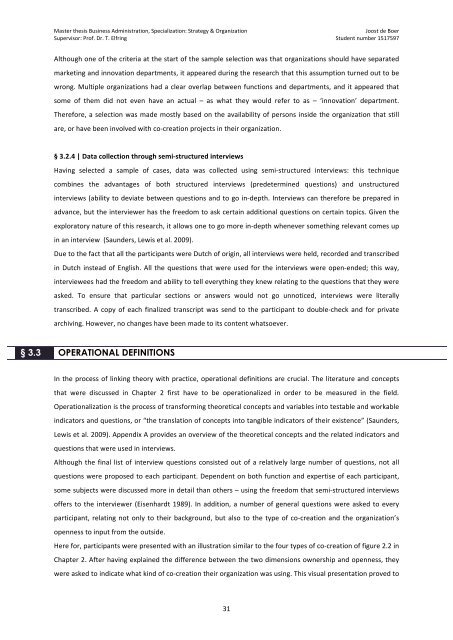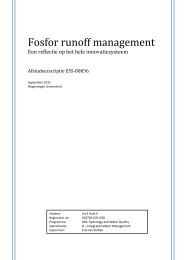Download PDF (English) - Future Ideas
Download PDF (English) - Future Ideas
Download PDF (English) - Future Ideas
Create successful ePaper yourself
Turn your PDF publications into a flip-book with our unique Google optimized e-Paper software.
Master thesis Business Administration, Specialization: Strategy & Organization <br />
Supervisor: Prof. Dr. T. Elfring <br />
Joost de Boer <br />
Student number 1517597 <br />
Although one of the criteria at the start of the sample selection was that organizations should have separated <br />
marketing and innovation departments, it appeared during the research that this assumption turned out to be <br />
wrong. Multiple organizations had a clear overlap between functions and departments, and it appeared that <br />
some of them did not even have an actual – as what they would refer to as – ‘innovation’ department. <br />
Therefore, a selection was made mostly based on the availability of persons inside the organization that still <br />
are, or have been involved with co-‐creation projects in their organization. <br />
§ 3.2.4 | Data collection through semi-‐structured interviews <br />
Having selected a sample of cases, data was collected using semi-‐structured interviews: this technique <br />
combines the advantages of both structured interviews (predetermined questions) and unstructured <br />
interviews (ability to deviate between questions and to go in-‐depth. Interviews can therefore be prepared in <br />
advance, but the interviewer has the freedom to ask certain additional questions on certain topics. Given the <br />
exploratory nature of this research, it allows one to go more in-‐depth whenever something relevant comes up <br />
in an interview (Saunders, Lewis et al. 2009). <br />
Due to the fact that all the participants were Dutch of origin, all interviews were held, recorded and transcribed <br />
in Dutch instead of <strong>English</strong>. All the questions that were used for the interviews were open-‐ended; this way, <br />
interviewees had the freedom and ability to tell everything they knew relating to the questions that they were <br />
asked. To ensure that particular sections or answers would not go unnoticed, interviews were literally <br />
transcribed. A copy of each finalized transcript was send to the participant to double-‐check and for private <br />
archiving. However, no changes have been made to its content whatsoever. <br />
§ 3.3 OPERATIONAL DEFINITIONS<br />
In the process of linking theory with practice, operational definitions are crucial. The literature and concepts <br />
that were discussed in Chapter 2 first have to be operationalized in order to be measured in the field. <br />
Operationalization is the process of transforming theoretical concepts and variables into testable and workable <br />
indicators and questions, or “the translation of concepts into tangible indicators of their existence” (Saunders, <br />
Lewis et al. 2009). Appendix A provides an overview of the theoretical concepts and the related indicators and <br />
questions that were used in interviews. <br />
Although the final list of interview questions consisted out of a relatively large number of questions, not all <br />
questions were proposed to each participant. Dependent on both function and expertise of each participant, <br />
some subjects were discussed more in detail than others – using the freedom that semi-‐structured interviews <br />
offers to the interviewer (Eisenhardt 1989). In addition, a number of general questions were asked to every <br />
participant, relating not only to their background, but also to the type of co-‐creation and the organization’s <br />
openness to input from the outside. <br />
Here for, participants were presented with an illustration similar to the four types of co-‐creation of figure 2.2 in <br />
Chapter 2. After having explained the difference between the two dimensions ownership and openness, they <br />
were asked to indicate what kind of co-‐creation their organization was using. This visual presentation proved to <br />
31





